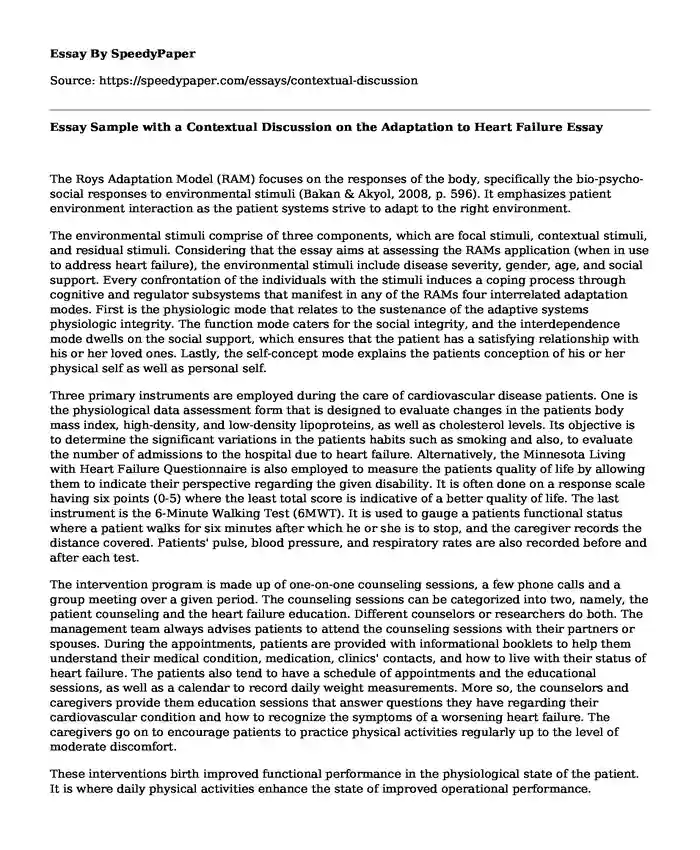
| Type of paper: | Essay |
| Categories: | Medicine Healthcare |
| Pages: | 3 |
| Wordcount: | 645 words |
The Roys Adaptation Model (RAM) focuses on the responses of the body, specifically the bio-psycho-social responses to environmental stimuli (Bakan & Akyol, 2008, p. 596). It emphasizes patient environment interaction as the patient systems strive to adapt to the right environment.
The environmental stimuli comprise of three components, which are focal stimuli, contextual stimuli, and residual stimuli. Considering that the essay aims at assessing the RAMs application (when in use to address heart failure), the environmental stimuli include disease severity, gender, age, and social support. Every confrontation of the individuals with the stimuli induces a coping process through cognitive and regulator subsystems that manifest in any of the RAMs four interrelated adaptation modes. First is the physiologic mode that relates to the sustenance of the adaptive systems physiologic integrity. The function mode caters for the social integrity, and the interdependence mode dwells on the social support, which ensures that the patient has a satisfying relationship with his or her loved ones. Lastly, the self-concept mode explains the patients conception of his or her physical self as well as personal self.
Three primary instruments are employed during the care of cardiovascular disease patients. One is the physiological data assessment form that is designed to evaluate changes in the patients body mass index, high-density, and low-density lipoproteins, as well as cholesterol levels. Its objective is to determine the significant variations in the patients habits such as smoking and also, to evaluate the number of admissions to the hospital due to heart failure. Alternatively, the Minnesota Living with Heart Failure Questionnaire is also employed to measure the patients quality of life by allowing them to indicate their perspective regarding the given disability. It is often done on a response scale having six points (0-5) where the least total score is indicative of a better quality of life. The last instrument is the 6-Minute Walking Test (6MWT). It is used to gauge a patients functional status where a patient walks for six minutes after which he or she is to stop, and the caregiver records the distance covered. Patients' pulse, blood pressure, and respiratory rates are also recorded before and after each test.
The intervention program is made up of one-on-one counseling sessions, a few phone calls and a group meeting over a given period. The counseling sessions can be categorized into two, namely, the patient counseling and the heart failure education. Different counselors or researchers do both. The management team always advises patients to attend the counseling sessions with their partners or spouses. During the appointments, patients are provided with informational booklets to help them understand their medical condition, medication, clinics' contacts, and how to live with their status of heart failure. The patients also tend to have a schedule of appointments and the educational sessions, as well as a calendar to record daily weight measurements. More so, the counselors and caregivers provide them education sessions that answer questions they have regarding their cardiovascular condition and how to recognize the symptoms of a worsening heart failure. The caregivers go on to encourage patients to practice physical activities regularly up to the level of moderate discomfort.
These interventions birth improved functional performance in the physiological state of the patient. It is where daily physical activities enhance the state of improved operational performance. Research has found that such a comprehensive program that incorporates educating the patient, training them on self-management techniques, and setting up an integrated multidisciplinary team to follow-up their progress shows significant benefits in the quality of the life of the patient and reduces the cases of hospitalizations. This process involves associating the physiological mode with the other three. It confirms that patients with a better physiological quality of life can carry out their other functions when they have social support.
References
Bakan, G., & Akyol, A. D. (2008). Theory-guided interventions for adaptation to heart failure. Journal of Advanced Nursing, 61(6), 596608.
Cite this page
Essay Sample with a Contextual Discussion on the Adaptation to Heart Failure. (2019, Oct 04). Retrieved from https://speedypaper.net/essays/contextual-discussion
Request Removal
If you are the original author of this essay and no longer wish to have it published on the SpeedyPaper website, please click below to request its removal:
- Free Essay on Advantages and Disadvantages of Technology
- Essay Example on Five-year Career Goals
- Free Essay on the Case of the Unmarried Couple
- Free Essay: Lessons from Narrative of Frederick Douglass Autobiography
- Free Essay: Can AI Take Over from Human Beings in Driving the Growth of the Economy?
- Bay of Dogs - Essay Sample in History
- Risk Analysis of Nissan Corporation, Free Essay Example
Popular categories




